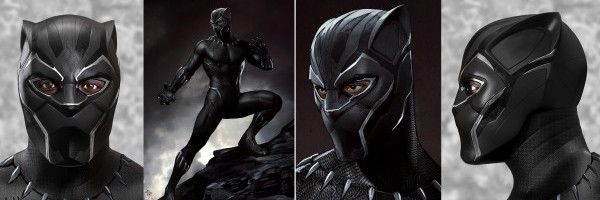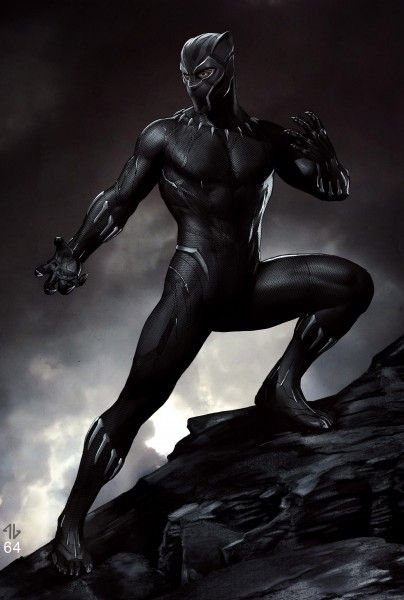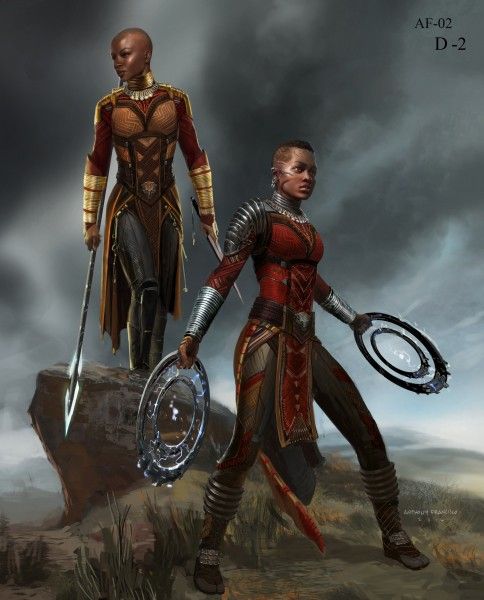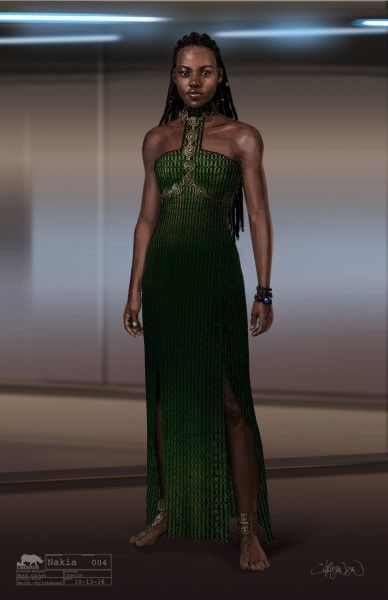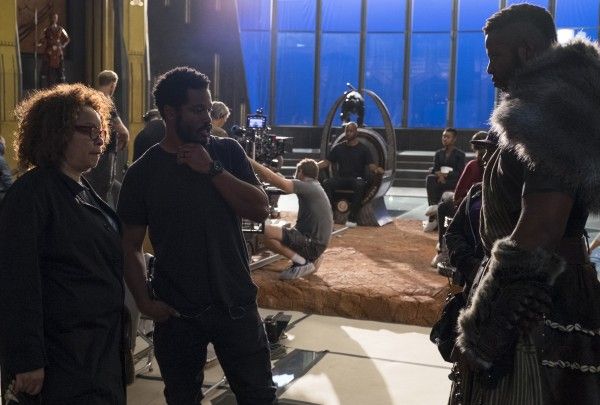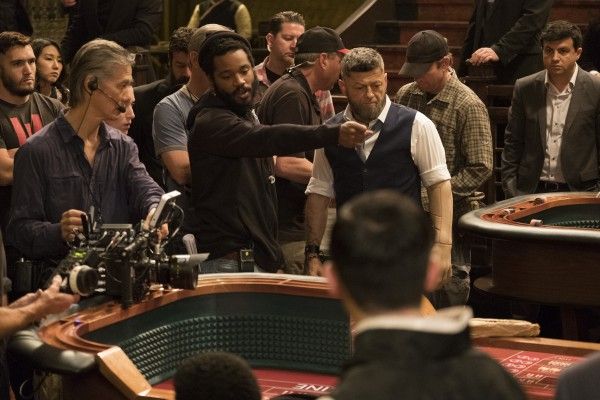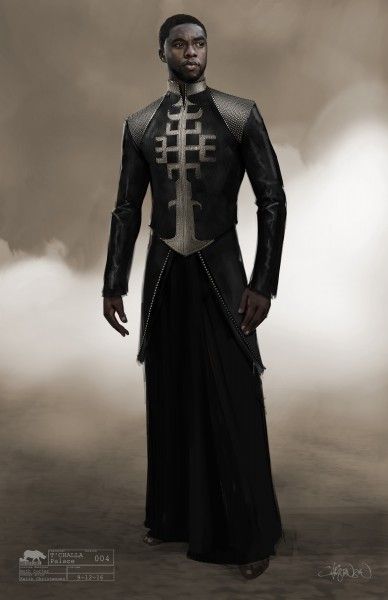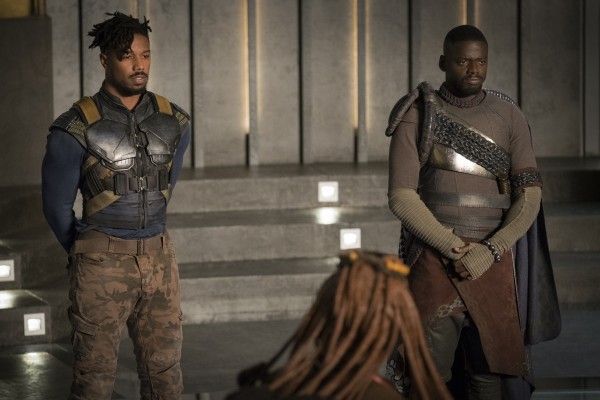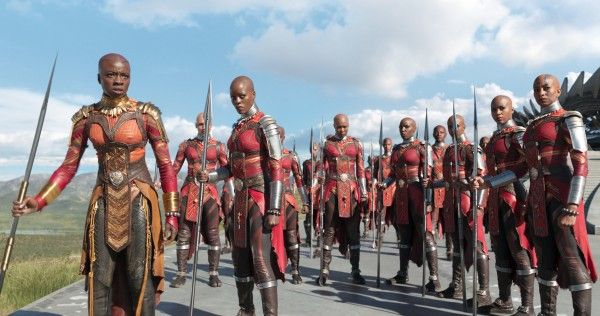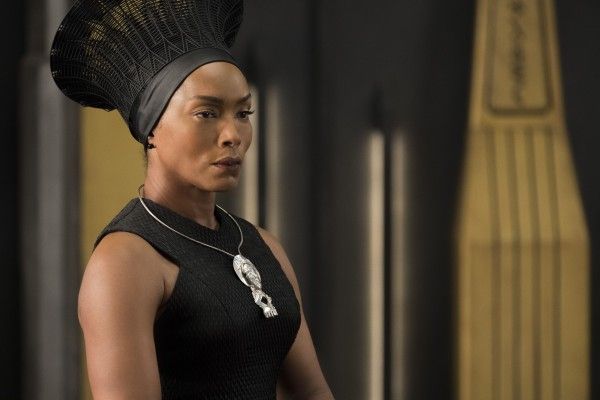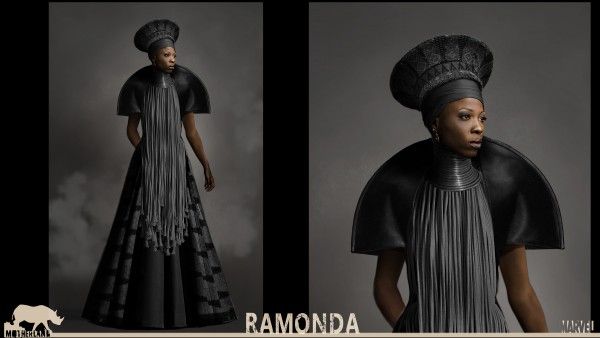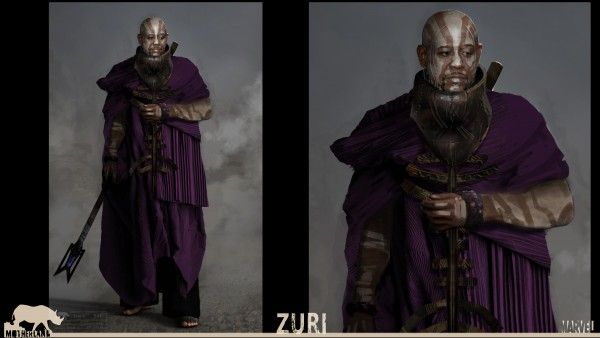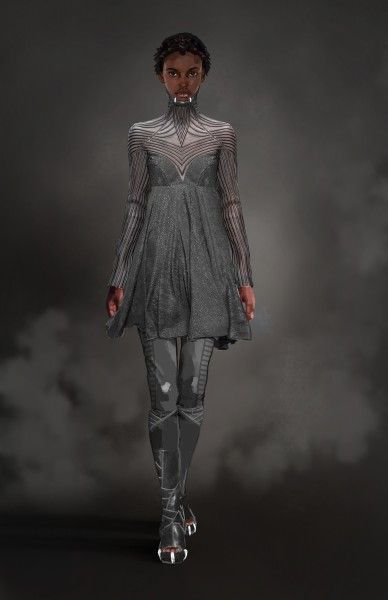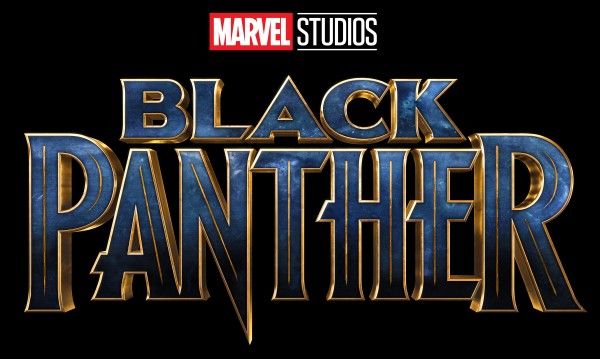If you're loving the look of the costumes on full display in Black Panther, you have one person to thank: Ruth E. Carter. The two-time Oscar-nominated costume designer celebrates 30 years in that role this year with one of the most anticipated movies ever to hit the big screen. A tall task, for sure, but Carter pulled all of her many resources together in order to find the look of Black Panther, Wakanda, and the characters who live within the nation ... and those who invade from without. Black Panther has some of the most stunning and unique visual motifs we've ever seen, and a richer meaning behind each bead and bit of tapestry, all thanks to Carter and her hard-working team.
When it comes to costuming questions, it's best to just stand back and let Carter work, which we found out during our set visit last year. She has such a wealth of knowledge that's literally available at her fingertips that it was a pleasure to just hear her talk about the inspirations, cultural significance, patterns, styles, and materials she used to pull off the look of Black Panther. It's plain to see that Carter and her team absolutely nailed it. Here's her insight on how it all came together.
Ruth E. Carter: The Marvel Universe is a brand new frontier for me. It’s been very exciting working with some of the most creative minds, I think, in the superhero world. We were great collaborators. We’ve done 5 months of, well, my part was 5 months, of developing some of the characters that everyone knows and loves.
Tell us a little bit about your collaboration with Ryan [Coogler].
Carter: So the director, Ryan Coogler, interviewed me and wanted my concept art in the very beginning of what I thought of the Black Panther and the Wakandan world. Of course, he couldn’t share a script with me, so I went out and read all the comic books and tried to gather up as much as I could. It’s really such a vast world it’s hard to capsulize it for a 30-minute interview. But I was able to collaborate with some of my ideas about it being a place that is well ahead. Futuristic in some ways, but not futuristic. A place in Africa that’s African, but also has a wide stretch of cultural awareness that reaches to the depths of many cultures, as well as, a beauty that unique amongst itself.
With that being said, looking at futuristic sci-fi just took you too far in one direction. Looking at Afro-centric or Afro-punk or African, there’s all kinds of places in Africa where you can draw your inspiration from. So I couldn’t stay in one region of Africa. I couldn’t stay in West Africa and make it Nigerian and Ghanaian, forget that there was East Africa which also has some great images and colors and textures. So, there was a Bible that was presented to me that Ryan developed that explained it all and explained what Wakanda was and explained the different tribes of Wakanda and where they came from. So there were pieces of all different points in Africa that were combined. And when you research those real places, like the Dogon or the Nigerian culture, you sometimes had a conflict of aesthetics. So it was up to me to meld the two cultures together and make it one unique for our Wakanda and for our look for the costumes. That was my first challenge. Learning curve beyond belief. Once that kind of got into my bones ai was able to really understand from the comic reader’s point of view what Wakanda was.
Looking at a lot of images that were painted in the comic strips you’d see people cheering in the streets, for example, as the Dora Milaje walked down carrying T’Challa on his chair. You kind of got the concepts and I think comics are mainly broad stroke concepts, especially in regards to costumes, because the costumes don’t generally really work in the way that real clothes do. The Dora Milaje, they’re walking in the middle of the road with a sarong and a tube top and tattoos – I mean, they look really great – mohawks and great little tiny sunglasses and we know that in the stunt world that kind of costume is just not going to work. Also, in regards to the Dora Milaje, we wanted to make them have more of a presence. More of a strength of authority. That they did have. They were badass chicks who were protecting the King, until T’Challa, being the Black Panther, is walking around in this skin suit. We didn’t want the guy in the skin suit walking around with the girls in the bathing suits. We developed more as a real warrior might be developed. Real warriors who need their arms protected and need to have shields, and armor, and weaponry and shoes – like they’re really going to go to battle. It took us some time to get there because, we all as women, want to be that girl who can fry up the bacon and do all the other stuff. But in the end, it’s got to feel empowering.
Also, in regards to T’Challa, the King, the Prince – we take it from his father’s death. He’s no longer King. And now he can be challenged. Others can challenge to take over his throne. So he starts out as our Prince. What we wanted to do, because there’s another element to the story I can’t tell you about – spoiler alert – that we wanted to juxtapose two things. Our Prince was very kingly. He was very clean, very tailored, what you would expect out of the son of a king. We also looked at a lot of embroidery and dashikis and things that people could relate to and we embellished his kingly clothes with those things. So that he’s a king that you know.
It became a process, too, because we’re in Wakanda. It’s a barefoot culture. So three out of five [people] can walk around bare foot. In this weather, I don’t know? Maybe as we keep shooting we’ll get to that. But we felt that in the typical sense of what happens in a throne room – you have the King and the crown and maybe, he’s head of the military. So we gave him two things: kind of an open sandal so that it felt like Africa, but he also wore a beautiful tailcoat. We gave him a lovely cloak adorned with Kente, and then we gave him military boot and pants. So he gives you two messages that he is princely, he is elegant but he is also the head of the military and we are in Africa.
With Nakia, which is Lupita [Nyong’o], she starts out as a War Dog, coming from Nigeria. She’s fighting for young Nigerian women who are captured by the mean guys who are militants that capture women and put them into slavery. So she starts out very tough. We see her immediately as a fighter. We know her as a fighter. She’s dusty and dirty and she wants to stay in that element. She’s comfortable there. I researched all kinds of fashionable War Dogs. All kinds of fashionable, dirty fighters and there’s a lot of good looks out there, so it was hard to pick one. But I think what we found for her was really great because it was very much not a part of Wakanda. It was a part of the world around and she travels into Wakanda and then she starts to gradually go back to her Wakandan roots, in that her color palate also changes. It starts out as a war dog in army greens and browns and earth tone dirty and army boots. Then as we greet her in other costumes, in other scenes, the greens become very clear. It’s more jade. It’s more teal. It’s a more put together but she still wears one earring and she still has her tough exterior but we start seeing a little more layer to her origin of being a Wakandan girl – the highest warrior of the River Tribe. Her tribe is the River Tribe. She’s the fiercest warrior of the River Tribe and her color is green. So I have examined every spectrum of green. Green is a wonderful color because, like nature, all greens work together well. That was fascinating because she’s such a beautiful tone. She can wear the chartreuse and the bottle green and all those greens so well.
The War Dogs have a specific costume in the comics. Was that ever considered?
Carter: I looked through a lot of that and it does have a little bit of a para-military feel to it and she had that but because she is a new character to this, I wanted to give her a look that she could follow. That we could follow her in and just add it to the fold. So it’s kind of like I said, you examine the comic books and you have a commitment to all of the comic book readers out there who love the series and love the Black Panther but also, I felt obligated to give them something more.
You’re creating these costume designs and creating a society through the costumes, while Hannah [Beachler] is working on the production design in creating the world that these costumes have to play in. How closely did you two work together so that these aesthetics were matching up?
Carter: I think Hannah and I are besties right now. Because we are constantly screaming and jumping up and down and hugging each other. We work very closely. We had a lot of visual development meetings where she showed us sets and I’m happy that we have this vast network at Marvel where I can plug in and open up all the beautiful set designs that Hannah has designed and be reminded of what they’re going to do. A lot of times things are blue screen. When you get to set, it’s a stairway and a blue screen, so you’re not necessarily getting fed all the time. But then there are some beautiful sets that we built here. I think they’re even more beautiful than they are on the page. The color palates. They were very strict about the color palates. There are the River Tribe, which is green. There’s the Border Tribe, which is blue. There’s the Panther and the Royal Palace, which is black and royal purple. The Jabaris, which are wood. We had a very clear direction and that came from Ryan. With Hannah, her taste levels are through the roof, so I was constantly becoming aware – and still visiting – as they’re developing the sets, seeing what lanterns are going in, the furniture – and still getting a surprise when I get to set. This business is always morphing and you’re always tweaking when you see things finally coming together.
You mentioned the cultural inspiration when creating these costumes. How do you accent the personality for each individual character?
Carter: That’s a good question. A lot of times the actors during fittings – a fitting for me is like a therapy session. *laughs* I’m asking, “What are you doing here?” and “Why are you here?” “What makes you’re friendship so special to T’challa?” and “What makes you guys nemeses?” “What makes you not get along?” I’m always asking those questions and part of the sub-conscious things that happens after you do a lot of research and you look at so many images, you might look at an image of a voodoo priest and might have a particular hood or sweater or cape or cloak. When you have that conversation with an actor, so of those images pop into your head and you think, “Hey, wait. Let me show you this. We should do that, because that communicates what you just told me.” And that’s kind of how we work together. That’s the fun part of my job.
How about in cases where the costumes have a CG element? What’s that been like for you?
Carter: Well, that’s really interesting, you know, because they put dots on their face, we have a strip of black-and-white tape and we tape it around their bodies. But for the most part, what Jeff Bowman, our special effects producer, has told us is that just be as creative as you envision it. And let us just take it from there. Don’t try to work in our world. Let us work in your world. So he basically asked me if I’m done. And they have a booth on set that has cameras in 360 degrees and in five minutes, they have every aspect of the costume photographed. And then they take it and then they manipulate it in any way that they see as proper for what they’re trying to accomplish. So he hasn’t bombarded me. And he’s also said, if there’s something you don’t like, if something is bugging you, let me know, and I can help you with that. And I thought, great! When does that ever happen? You know, like, ‘I really wanted her shoes to be black instead of brown, how about that?’ I don’t think it as detailed as that. But pretty much I haven’t been asked to give anyone a blue suit. At most, I’ve been asked to give someone a sleeve with a blue band on it so they could remove something.
You talked earlier about the colors for each character and how they morph and change. With the big four - we’re talking Lupita, Danai, Michael, and Chadwick - do they each get a texture? Earlier, Hannah was talking about the textures of each production set, like some had glass or sand.
Carter: Oh yeah. That’s great. Well, yeah, there’s also textures. River tribe, you know, the river and shells, we didn’t use shells with anyone else unless they were part of the river tribe, and that’s Nakia’s tribe. Border tribe is wood, and wood grain, and strength, and we have a character who we made all of his armor out of wood and there’s definitely - it’s all about textures. I worry a little that as we photograph lots of textures, sometimes you get a buzzing or sensation that happens on film with beads, you know. In African culture there’s tons of beads. Beads everywhere. I have beads everywhere. And so those kinds of textures are throughout the film. And then some new things that we have created, because I feel like it’s a mix of old tradition and new. So there’s some foiling that’s happening, and there’s some Miyake style pleating that’s happening, too.
What did you like about the original Black Panther costume that you were able to use to help inform you?
Carter: Yeah, I liked the original Black Panther costume. I liked his helmet and I liked his boots and I liked a lot of things about it. But what we wanted to do was take it into a new millennium, a new attitude, a new technology, and make it exciting again. You know, just make it exciting again. And then sometimes, you know, cultures can come together with superheroes. And I’ll leave it at that.
How do you work with Ryan to make sure the functionality of the suit is justified within the story?
Carter: Yes. There are a lot of meetings. And a lot of talking. And a lot of show and tells. I’ve always loved show and tells, so that was fun for me. We do a lot of prototypes. We would make up an arm. Actually, we made up six arms. And then we put them on the center of a conference table for one of our big meetings to show what the surface texture could look like, how it could change, what the Man of Steel - what did Superman have under his suit? What different things could we explore that - you know, there’s only so far you can go. You can’t all of a sudden have like a fur cape, you know. So within the parameters of our superhero, what could we add and what could we compete with that would raise the bar for him and keep him in the same genre as Superman and Batman and all the other guys, you know, bad-ass superhero.
I noticed in the scene that’s being filmed today, the costumes that the Wakanda characters are wearing feel a little visually distinct. Like it’s a lot of hoodies and motorcycle jackets. I was wondering if that was intentional because they’re outside of Wakanda, and if so, if there a trick to creating a Wakandan street style that works outside of the country?
Carter: Who’s in a hoodie and a motorcycle jacket? I only bought one hoodie and I haven’t used one motorcycle jacket.
Really? I could be wrong, but it looked like Nakia was wearing something …
Carter: Oh, you saw that! Mmm. Well, I told you she was from outside of Wakanda.
That’s true.
Carter: And she is in green, did you notice that? And we are in a black site. CIA black site. So they’re kind of undercover. So they put on their street clothes that are kind of American to fit in. But one is in all green and the other, who is a Dora, is in all red, sort of. So in their way they put on a disguise. But you’ll see that it’s very much in line with … yeah. That is a motorcycle-style jacket. It’s by a designer called Azzedine Alaïa, and we totally manipulated it. We dyed it and cut it shorter and manipulated it and made it her own. So that’s what it is. A CIA black site. So they’re doing a whole little thing. And you’ll notice that T’Challa has on a sweatshirt hoodie. Forgot all about that article of clothing. And jeans and black tennis shoes. That’s very different from what they usually are wearing.
I’m hoping you can talk a bit about Erik Killmonger. In the comics, he’s not a big fan of shirts. I’m curious …
Carter: Ah. He looks fantastic. He has a specialty costume that he wears today, but I think he’s only gonna be wearing it on set. He probably is not gonna walk around in it. But I think that there are some really exciting costumes in this one. You won’t be disappointed.
What are some of the influences you had for the Dora costumes? I know you said you wanted it to be functional.
Carter: Yeah, well, when you look at all the tribal work and you see a lot of red, you know, there’s a common color in African tribal cultures, red, yellow, white is used quite a bit. And so we wanted to make sure that the colors themselves were reminiscent of tribal colors that we know. And it’s really a primary red and a really tomato-y orange. You see a lot of plaids in Mali, in some of the Maasai tribes. You see that a lot. You see the red painted skin in the Himba tribe. You see a lot of the clay work. And in the Dora Milaje in the comic strips, they are red. That’s pretty much their color. So we wanted to stay with that, number one.
Number two is, they have a tabard that they wear across the front of their costume. For a very long time I could not figure out why the tabard, why the tabard. It was approved and I kept wanting to get rid of it but it just wouldn’t go away. So I said, this tabard that’s kind of a harness — like I call it a harness now, in the beginning I called it a tabard — needs to mean something. If they all wear this tabard, and it doesn’t hold a sword, it doesn’t hold a gun, it doesn’t do anything but stay there in the front, it has to have a meaning. So I beaded it. And I put little charms on it for protection. Because that to me also felt like it was a part of the African culture to have little talismans on things for protection and good luck and good spirit. So there’s three places on the tabard where they wear a little shield, a little amethyst stone, and I think it’s a piece of jade.
The rest of it is beaded, and I wanted the beading to look very earthy. Very earthen. And feel like something that could be handed down. Like you could take your harness and give it to your daughter, and when she became a Dora Milaje, and you could wear her tabard. I felt like it was one of those kinds of pieces that they had. The rest of it’s tights and a leotard, what can I tell you? And a beautiful design. But the harness and the tabard, that was the special piece of the Dora Milaje for me.
How does the Wakandan style, especially street style, reflect their relationship with the outside world or the lack thereof?
Carter: I think it says that they’re not in outer space, that they still like to wear, you know, Nikes that light up, and yellow hats and big kooky glasses, and they still wear natural hair, and they still like to combine prints like everybody else does. But I think what it also says is that there’s a different kind of a freedom that they enjoy. And that it’s because they have such a tight culture, the different tribes, they do co-mingle. It’s just a place that has the same kind of rules and regulations, I think, that the other world, the outside world does. You know, there are bad kids in the park. And there’s a merchant district, there’s a hospital district.
I took each district and gave it a name that I could relate to and remember easily. So I said Step Town was like Brooklyn. Or NYU. And then I’d say another district was like the Upper West Side, where there’s more families and it’s more settled down, but it’s still New York. I used Manhattan, basically, as my way of remembering how I was going to view different parts of Wakanda. And it kind of did make sense, you know. There’s an area that’s mainly medical, so I was like, yeah, that’s like UCLA medical area. You know, you get into some of those communities and it’s all the doctors and people walking around. There’s different district of Wakanda.
And then I’d say, how do I make it look unique to us? In that it’s a barefoot culture, they’re advanced in technology. What are they wearing? Is it corny to have something lighting up? Our DP she walks around with her headset on, and the light is blinking all the time. And I was like, Wakanda! It’s like here everyday. So that’s kind of how I feel like you can actually, after watching this film, see things that way, you could point at and say, that’s Wakanda.
For much more of our coverage on Black Panther, be sure to check out these recent write-ups and keep an eye out for much more to come:
- ‘Black Panther’: Chadwick Boseman on T’Challa’s Ascension to Wakanda’s Throne
- ‘Black Panther’: Andy Serkis on Klaw’s Return & the Mercenary’s Conflict with Wakanda
- ‘Black Panther’: Michael B. Jordan on Erik Killmonger’s Mission in Wakanda
- ‘Black Panther’: 90 Things to Know about the MCU’s Game-Changing Movie
- ‘Black Panther’: Lupita Nyong’o on Nakia’s Role in the Political Turmoil in Wakanda
- ‘Black Panther’: Martin Freeman on Just What Everett Ross Is Doing in Wakanda

